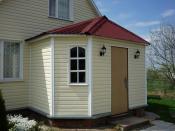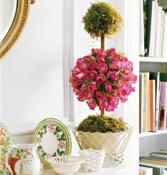Search
Login
Spiral staircase in a private house with your own hands, design and self-assembly
In recent years, the construction of country houses not in one but in several floors has become a kind of tradition. Of course, the staircase for such a house is an integral attribute not only of necessity, but also an additional element of the interior, with which you can emphasize the special style of the room and create the appropriate atmosphere in it. In this article we will look at all the existing types of stairs and talk in detail about how to make a spiral staircase in a private house with your own hands.
Content
- Types of stairs video
- The main elements of the stairs
- What material to prefer when arranging a staircase
- Spiral staircase design
- DIY elements of a wooden spiral staircase
- Spiral staircase installation video
Types of stairs

Before proceeding with the design of the stairs, it is necessary to carefully familiarize yourself with all types of structures and choose the most suitable option for yourself.
As a rule, in a country house they mount one of three types of stairs on rails, marching or spiral.
Any of these types of stairs can be used both as a walk-through staircase and as an entrance or interfloor staircase.
These types of stairs are made from a variety of materials of artificial and natural stone, concrete, wood, metal, reinforced concrete, plastic and even glass.
And it is necessary to choose the material from which you will make the staircase, not only for financial reasons, but also on the basis of what loads it will succumb to and its purpose.
Now let's look at the features of a particular type of staircase.
Stairs. The name of this type of stairs for a private house comes from the word Bolzen, which in translation from German means a bolt. Actually, this type of stairs got its name for a reason, since the steps in it are stacked on a special structure fastened to the wall by means of bolts or screws. That is, to create such a staircase, you must have a solid stone wall on one side of the stairs. But the stairs on the stairs can help you save on materials and are compact, which is important if there is a limited amount of free space.
The frame in such stairs is created from metal elements (pipes, rods and bolts), and the steps are made of metal, glass or wood.

Marching stairs. This type of stairs is most often used in private homes, as they are the easiest to arrange and convenient to use. One of their main disadvantages is the need for a large space. In order to at least somehow save precious meters without sacrificing convenience, rotary marching stairs are increasingly being equipped. In addition to them, there are also circular marching stairs, half-turn, quarter-turn and curved marching stairs.

Spiral staircases. This type of stairs is often used when necessary, austerity of space, as well as in places where to equip a straight staircase is not possible. A spiral staircase will undoubtedly give originality to the interior, but you still have to forget about such a concept as convenience with such a staircase. To create such a ladder, you can use absolutely any materials: wood, metal, glass, etc.

Spiral staircases in a private house can be of four types:
- steps rest on a support rack;
- steps are based on a fence or bent bowstrings;
- with pinching steps in the support rack;
- steps are based on a support stand or on walls located around the perimeter.
The main elements of the stairs

Like any building structure, the staircase consists of individual elements. Depending on the type of stairs you choose, you may need different elements, however, there are also basic details that are necessary regardless of the type of construction, these are the steps and the supports supporting them.
Support beams. Bowstring beams supporting both the bottom and the ends of the step. Kosoura beams supporting steps from below. When three braids are used, the middle one is called intermediate. These two types are more often used to equip marching stairs, but when installing spiral staircases, poles are used.
Tread part of the step, which is a horizontal surface. Riser also part of the step, more precisely, its vertical part. This element of the stairs is optional and is an additional support for the steps.

Supporting Elements. Rack supporting element of a spiral staircase. Bolts wall-mounted bolts on which stair steps are mounted.
Flight of stairs consists of several steps and railings. The flight of stairs serves to climb one level and is divided, as a rule, by landings.
Very often, although not always, details such as railings are used. Additional enclosing elements of handrails, metal racks, rods can also be used.
Baluster the vertical element of the staircase, which is a rack. Additionally, this part is also an ornament. The whites are made of marble, brass, cast iron and bronze.
What material to prefer when arranging a staircase

As we have already mentioned in this article, stairs can be made of a variety of materials: wood, metal, marble, granite, concrete, even such a material as glass today is no longer surprising. When choosing a material for a ladder, first of all, it is necessary to pay attention to its durability and strength. This is especially true for the steps of the stairs, since they are the main load.
So, the materials that are most often used in the arrangement of stairs:
- Tree. Most often, stairs in a private house are made of wood. In this case, the most durable for the steps is mahogany, walnut, wenge, dessie and teak wood. These rocks are most resistant to both mechanical stress and humidity and atmospheric pressure. Also quite good resistance to mechanical stress demonstrate beech, oak and maple. But the pine for the arrangement of stairs is not recommended, because it is soft. A little stronger pine, cherry, pear and larch.

- Metal. Stairs made of this material can also often be seen in private homes. It is recommended to use stainless steel for stairs, since it is the most durable and durable, and its service life exceeds 40 years.

- Stone stairs pleasure is expensive. However, if finances allow you to equip a staircase made of stone, it is best to use granite or quartzite for this purpose. Also pay attention to the artificial stone on a concrete basis, it also has high strength. But it is not recommended to use marble or agglomerate for stairs, since after two years of service the steps of marble will begin to wear out.

- Glass. If when arranging the stairs, you decide to use glass, then in this case it should be tempered or laminated.

Spiral staircase design
Designing a spiral staircase, as well as designing any element during the construction of a house, is the most important, complex and lengthy stage. So, during the construction of a spiral staircase, steps are best done from the riser. This is due to the fact that when arranging such a staircase, the width of the steps narrows closer to the axis. Therefore, if there is a riser, there is a risk that when moving up the stairs, the leg may slip, while without the riser the leg will be better fixed on the step.
It is necessary to pay attention to the width of the step itself, it should not be less than 20 centimeters in the center of the span. At a distance of 15 centimeters from the axis, the width of the step should not be less than 10 cm.
It is also important not to forget that the distance between adjacent turns should not be less than two meters, so as not to interfere with the movement of a person.

For the central axis, it is best to use a steel pipe with a diameter of 50 millimeters, which is installed strictly vertically between floors. When calculating the number of steps and the height difference between them, it is necessary to take into account the thickness of the steps themselves, as well as the height of the bushes (mounted between the steps) and washers (installed at the joints of the steps and bushes).
The length of the steps themselves will depend on where exactly the spiral staircase will be located and on the opening in the floors. And their number can be determined by dividing the height difference between floors by the height of one step. In accordance with the standards, the height of one step, taking into account the thickness, should be no more than 18-20 cm.
All steps are overlapped so that one partially overlaps the other. This will make it possible to strengthen the entire structure using brackets that are located between the edges of a wide part of the steps.
some examples of spiral staircase drawings
Spiral staircase drawings:





spiral staircase calculation

As an example, we give the calculation of a spiral staircase with a height of three meters and a width of 0.9 meters. Our staircase will be located on the central rack, the diameter of which will be 0.25 m.
When calculating a spiral staircase, the diameter of the planned staircase is initially determined. It is determined as follows: two widths of steps (2 * 0.9m) must be added to the diameter of the rack (0.25m).
Thus: 2 * 0.9 + 0.25 \u003d 2.05m
The total diameter of the rack will be 2.05 meters.
To determine the radius of the circle, indicating the trajectory of a person along the stairs, it is necessary to divide the width of the stairs and the diameter of the support column in half:
(0.9 + 0.25) / 2 \u003d 0.575 m.
To determine the required number of steps for one turn, we will need to divide the circumference of the path of a person along the stairs by the value of the step width of 0.2 m.
2*3,14*0,575/0,2=18,055
Thus, for each turn we will require 18 steps.
The height of the turn is determined by adding the average height of the person (1.85 cm.), The thickness of the steps (0.05 cm.) And a small margin of 0.1 m. Thus, having determined that the height of each turn will be two meters, we can find out what height each step should be:
2m / 18 \u003d 0.11m.
For the entire staircase, three meters high, we need 27 steps 3 / 0.11 \u003d 27. To calculate the final height of each step, we must again divide the height of the entire staircase by the number of steps 3/27 \u003d 0.11. In contrast to our case, as a rule, in this case, a slightly adjusted value is output.
DIY elements of a wooden spiral staircase

Today, in the market you can find ready-made elements of the stairs, and you can also get a variety of ready-made spiral staircases. However, if there is a desire to create a staircase with your own hands, then you can try to make these same elements yourself.
For the manufacture of wooden steps for a spiral staircase, it is best to give preference to species such as oak or beech. For these purposes, it will be easiest to use ready-made rectangular steps, and then just fit them to the size and shape you need. After the steps are ready, you can cover them with several layers of parquet varnish or paint them, if the style of the interior of the room requires it.
After the paint or varnish is completely dry, it will be necessary to attach bushings to each step, with which the steps will be held at the support column.
For the manufacture of whites, you can use wooden rods or metal rods. Also, as an option, you can buy ready-made whites.
Many more problems will arise when making handrails and bowstrings with your own hands. Straight bars can be used as a railing, however, such structures will look spectacular only with the appropriate environment. Another thing is bent railings, which in almost any interior will look great.
Certain knowledge and skill will require the manufacture of a bowstring. To obtain the desired bend, the wooden blanks must be kept in boiling water so that the material softens and it can be bent in a certain way. A more easily curved bowstring can be obtained by gluing thin lamellas together.
Spiral staircase installation

After all the details of our stairs are ready, you can proceed directly to the installation. To do this, we strung the steps on the installed rack so that they overlap one another by at least 5 centimeters. At the same time, each step should be fixed with bolts, and a ready-made stand with steps is attached to the ceiling and floor. On the opposite side of the pillar are a bowstring or whitewash.
As you can see, the installation of a spiral staircase itself is quite simple and is unlikely to cause special difficulties. The main thing in the arrangement of the stairs is not to lose with the choice of the design itself, as well as with the material. It is also important if you decide to create all the elements of a spiral staircase with your own hands so as not to be mistaken with the size and shape of the parts.





